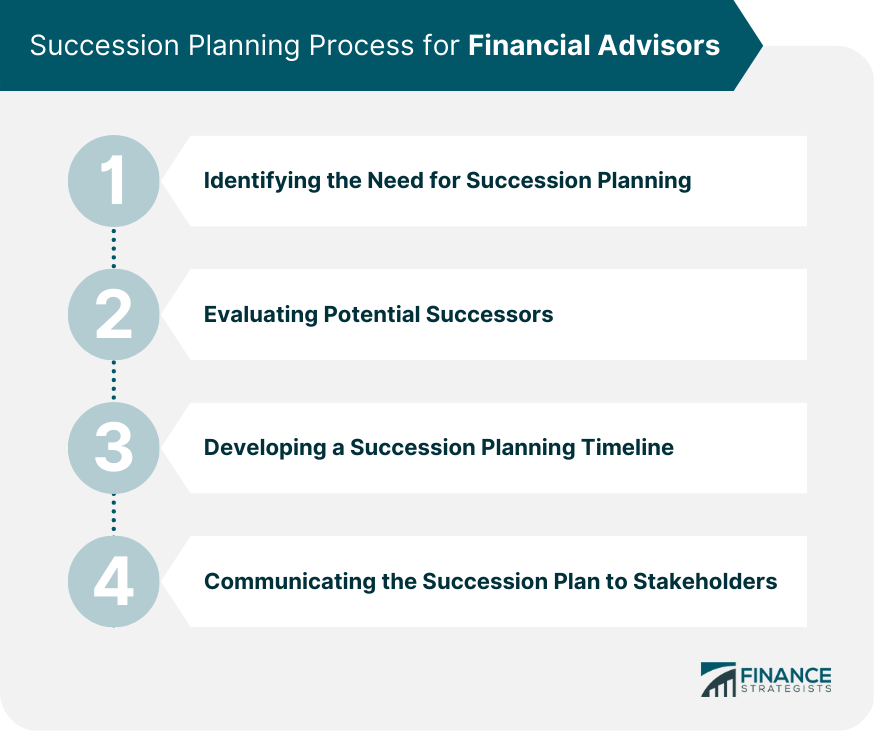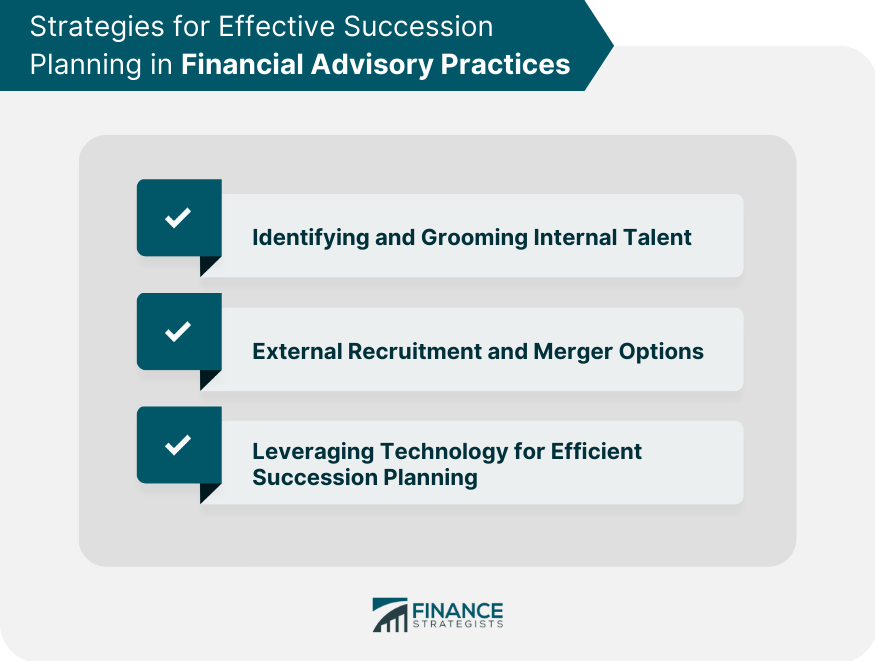Succession planning is the process of identifying and developing potential successors for key leadership roles within an organization, ensuring a seamless transition when the time comes. For financial advisors, succession planning is essential to maintain the continuity of their business, safeguard the interests of clients, and protect the value of the practice. The primary objectives of succession planning for financial advisors include: Ensuring the continuity of services to clients Preserving the value of the financial advisory practice Facilitating a smooth transition for the retiring advisor Minimizing disruption to staff and other stakeholders Succession Planning Process for Financial Advisors is a critical aspect of ensuring the long-term sustainability and success of a financial advisory practice. The need for succession planning arises from various factors, such as the advisor's age, health, career goals, and market conditions. Financial advisors must periodically review their practice and assess the necessity for succession planning to ensure long-term success. When considering potential successors, financial advisors should assess candidates' qualifications, experience, compatibility with the practice's culture, and ability to maintain client relationships. A thorough evaluation process can help identify the most suitable successor. A well-planned timeline is crucial for effective succession planning. Financial advisors should allocate sufficient time for identifying potential successors, training them, and gradually transferring responsibilities. This timeline should also factor in any unexpected events, such as illness or sudden departure. Transparent communication with stakeholders, including clients, staff, and regulatory authorities, is essential for a smooth succession. Keeping everyone informed and addressing their concerns can help alleviate anxiety and build trust in the process. By addressing these aspects effectively and adhering to ethical practices, financial advisors can safeguard their clients' interests and uphold the standards of the industry during the succession process. Legal considerations, such as contracts, partnership agreements, and non-compete clauses, must be thoroughly reviewed to ensure a seamless transition. Engaging an attorney with experience in financial advisory succession planning can help navigate these complexities. Financial advisors must adhere to the regulations set by bodies such as the SEC and FINRA. Ensuring regulatory compliance during the succession process is crucial to avoid penalties and maintain the practice's reputation. Ethical considerations, such as client confidentiality and fiduciary responsibility, must be maintained throughout the succession process. Adhering to a strict code of ethics can protect clients' interests and uphold the practice's integrity. By effectively managing the financial aspects of succession planning, financial advisors can ensure a smoother transition and protect their clients' interests. Determining the value of a financial advisory practice involves assessing factors such as revenue, client base, growth potential, and market conditions. Engaging a valuation expert can help establish a fair value for the practice. Various financing options, including seller financing, bank loans, and equity partnerships, can facilitate succession planning. Evaluating the most suitable financing option depends on the financial advisor's goals and the practice's financial health. Succession planning can have significant tax implications, such as capital gains tax and estate tax. Consulting a tax professional can help financial advisors minimize tax liabilities and maximize the value of the practice. Strategies for Effective Succession Planning in Financial Advisory Practices are essential in ensuring a smooth and successful transition of leadership and client relationships. Nurturing and developing internal talent can be an effective strategy for succession planning. Financial advisors should identify potential successors within the organization and invest in their professional growth through mentoring, training, and exposure to various aspects of the business. In some cases, recruiting external talent or merging with another practice can be a viable strategy for succession planning. Financial advisors should carefully assess the compatibility of potential candidates or merger partners to ensure a smooth transition. Technology can play a crucial role in streamlining the succession planning process. Tools such as CRM systems, financial planning software, and communication platforms can help financial advisors manage client relationships, monitor the practice's performance, and facilitate a seamless handover. By tackling challenges head-on and implementing effective best practices, financial advisors can secure the long-term success of their practice while ensuring continuity of service for their clients. Some common challenges in succession planning include: Identifying suitable successors Managing client expectations and maintaining relationships Navigating legal and regulatory complexities Addressing financial considerations and tax implications To overcome these challenges, financial advisors can: Develop a clear succession plan and timeline Communicate effectively with stakeholders Seek professional assistance from experts in legal, regulatory, and tax matters Continuously review and update the succession plan to adapt to changing circumstances Start the planning process early Involve stakeholders in the succession planning process Establish a mentorship program to groom potential successors Regularly evaluate the succession plan's progress and adjust as needed These case studies serve as valuable learning tools for financial advisors seeking to secure the future of their practice and ensure a seamless transition for clients and stakeholders alike. A family-owned financial advisory practice successfully transitioned to the next generation by involving the successor early in the business, providing comprehensive training, and gradually transferring responsibilities over several years. This approach ensured the continuity of client relationships and preserved the practice's value. A financial advisory practice sought a merger with a compatible firm to ensure its succession. By carefully evaluating potential partners and negotiating terms that benefited both parties, the practice achieved a smooth transition and continued to grow under the new leadership. A financial advisory practice promoted a senior employee to succeed the retiring advisor. The practice invested in the employee's professional development, allowed them to assume increasing responsibilities, and ensured a seamless handover of the client relationships. Succession planning is a crucial process for financial advisors to ensure the continuity, success, and preservation of their practice's value. From identifying potential successors and developing a succession timeline to navigating legal, regulatory, and financial considerations, careful planning and execution are imperative. Embracing technology and adopting best practices can further streamline the process and enhance the chances of success. As the financial advisory landscape continues to evolve, advisors must remain proactive in updating and refining their succession plans. By investing in the professional development of successors and fostering a culture of continuous learning, financial advisors can navigate the challenges of succession planning effectively.Definition of Succession Planning for Financial Advisors
Purpose of Succession Planning for Financial Advisors
Succession Planning Process for Financial Advisors

Identifying the Need for Succession Planning
Evaluating Potential Successors
Developing a Succession Planning Timeline
Communicating the Succession Plan to Stakeholders
Legal and Regulatory Aspects of Financial Advisor Succession Planning
Financial Implications of Succession Planning for Financial Advisors
Valuing a Financial Advisory Practice for Succession Planning
Financing Options for Succession Planning in Financial Advisory
Tax Implications of Succession Planning for Financial Advisors
Strategies for Effective Succession Planning in Financial Advisory Practices

Identifying and Grooming Internal Talent
External Recruitment and Merger Options
Leveraging Technology for Efficient Succession Planning
Challenges and Best Practices in Financial Advisor Succession Planning
Common Challenges in Succession Planning for Financial Advisors
Overcoming Obstacles in Financial Advisor Succession Planning
Best Practices for Successful Financial Advisor Succession Planning
Case Studies of Successful Financial Advisor Succession Planning
A Family-Owned Practice Example
A Merger and Acquisition Example
An Internal Promotion Example
Conclusion
Succession Planning for Financial Advisors FAQs
Succession Planning for Financial Advisors is crucial to ensure the continuity of their business, protect the interests of clients, preserve the value of the practice, and facilitate a smooth transition for the retiring advisor.
Technology can streamline the succession planning process by providing tools such as CRM systems, financial planning software, and communication platforms, which help financial advisors manage client relationships, monitor the practice's performance, and facilitate a seamless handover.
Common challenges in Succession Planning for Financial Advisors include identifying suitable successors, managing client expectations and maintaining relationships, navigating legal and regulatory complexities, and addressing financial considerations and tax implications.
Best practices for successful Financial Advisor Succession Planning include starting the planning process early, involving stakeholders in the process, establishing a mentorship program to groom potential successors, and regularly evaluating and adjusting the succession plan as needed.
Financial advisors can overcome obstacles in Succession Planning by developing a clear succession plan and timeline, effectively communicating with stakeholders, seeking professional assistance from experts in legal, regulatory, and tax matters, and continuously reviewing and updating the succession plan to adapt to changing circumstances.
True Tamplin is a published author, public speaker, CEO of UpDigital, and founder of Finance Strategists.
True is a Certified Educator in Personal Finance (CEPF®), author of The Handy Financial Ratios Guide, a member of the Society for Advancing Business Editing and Writing, contributes to his financial education site, Finance Strategists, and has spoken to various financial communities such as the CFA Institute, as well as university students like his Alma mater, Biola University, where he received a bachelor of science in business and data analytics.
To learn more about True, visit his personal website or view his author profiles on Amazon, Nasdaq and Forbes.











